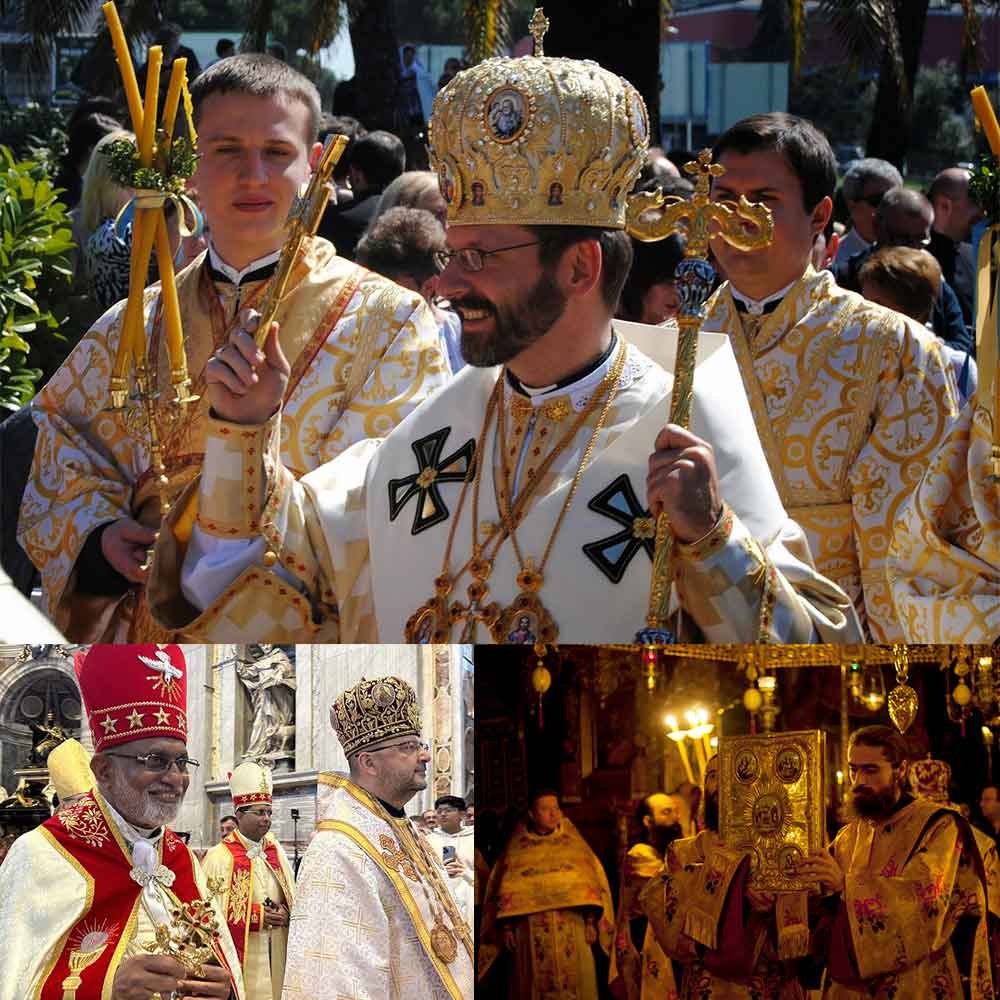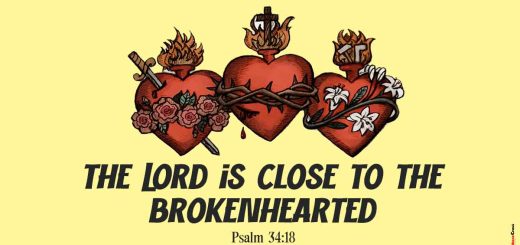The Catholic Rites of the East

Top: His beatitude Sviatoslav, Patriarch of Ukrainian Rite Catholic Church wearing Engolpia and Pectoral Cross (Byzantine rite)
Bottom left: Divine Liturgy in the East Syriac rite at the Jubilee of Eastern Churches, Vatican. Bottom right: A deacon carrying the Gospel book – Byzantine Rite
The Eastern Catholic Churches comprise 23 particular churches that are in full communion with the pope and the Holy See but maintain their own distinct liturgical practices, theological traditions and governance structures.
These churches are characterised by their Eastern Christian heritage and often follow the traditions of the Orthodox Churches. Each Eastern Catholic Church has its own liturgical rites, which can differ significantly from the Roman rite used in the Latin Church. These rites include particular prayers, hymns, and rituals that reflect their cultural and theological heritage. Many Eastern Catholic Churches use ancient languages such as Greek, Syriac, Arabic, and Ge’ez in their liturgies.
While all Eastern Catholic Churches share a belief in the core doctrines of the Catholic faith, they may have distinct theological emphases and traditions that reflect their historical and cultural contexts. Eastern Catholic Churches often have their own hierarchies, with patriarchs, major archbishops and bishops who govern their faithful in accordance with their own canon law, but they all remain in communion with the pope. Some of these leaders are elevated to the rank of cardinal.
Many of these churches have a presence in the Holy Land, but the patriarch of Jerusalem, currently Cardinal Pierbattista Pizzaballa, belongs to the Latin-rite (or Roman Catholic) Church. There are the six “Patriarchs of the East” mentioned below and four patriarchs in the Latin-rite Church: the heads of the sees of Jerusalem, Lisbon, Venice, and the East Indies (vested in Goa, India).
Here are the main Eastern Catholic Churches:
Maronite Church
Who are they? Primarily based in Lebanon, the 3,4 million-strong Maronite Church has a distinct liturgy and is known for its close ties to the Latin Church. Parts of South Africa, especially Johannesburg, have a strong Maronite community.
Their leader: The Maronite Patriarch of Antioch (currently Patriarch Cardinal Bechara Boutros al-Rahi).
Chaldean Catholic Church
Who are they? The 420,000 Chaldean Catholics use the East Syriac liturgy and are primarily based in Iraq and among the Iraqi diaspora.
Their leader: The Patriarch of the Chaldeans (currently Patriarch Cardinal Louis Raphaël I Sako).
Byzantine Catholic Churches
Who are they? These include the Melkite Greek, Ukrainian Greek, and Ruthenian Greek Catholic Churches. They primarily use the Byzantine liturgical tradition and Greek or Slavonic languages in their worship. The Melkite Church is prominent in the Middle East, especially in Syria. The Ruthenian Church is based in Eastern Europe and North America, with its headquarters in the United States.
Their leaders: The Melkite Church is currently headed by Patriarch Youssef Absi; the Ukrainian Church by Archbishop Sviatoslav Shevchuk; and the Ruthenian Church by Archeparch William Skurla.
Syriac Catholic Church
Who are they? The Syriac Catholic Church’s 200,000 members follow the West Syriac liturgy and has roots in the ancient Christian communities of the Middle East. Its faithful are primarily found in Lebanon, Syria, Iraq, and Turkey, with its headquarters in Lebanon.
Their leader: The Patriarch of Antioch and all the East for the Syriacs (currently Patriarch Ignatius Joseph III Yonan).
Coptic Catholic Church
Who are they? All of Egypt’s Christians are known as Copts, regardless of denomination. The 210,000 Catholic Copts follow the Alexandrian liturgical tradition and are a full part of the Coptic Christian heritage of Egypt.
Their leader: The Patriarch of Alexandria for the Copts (currently Patriarch Ibrahim Isaac Sidrak).
Ethiopian Catholic Church
Who are they? Ethiopia’s Eastern Catholics follow the Ge’ez liturgical tradition. The 20th-century redrawing of borders placed many believers in Eritrea, prompting the Vatican to establish the Eritrean Catholic Church headquartered in Asmara.
Their leader: The Metropolitan of Addis Ababa (currently Cardinal Berhaneyesus Demerew Souraphiel).
Armenian Catholic Church
Who are they? Following the Armenian liturgical tradition, one of the oldest in Christianity, the Armenian Catholic Church, with 150000 members, is also present in Georgia.
Their leader: The Catholicos of Cilicia (currently Patriarch Raphaël Bedros XXI Minassian).
Syro-Malabar Church
Who are they? Based in India and headquartered in the city of Kochi in Kerala state, this Church follows the East Syriac liturgical tradition, which it shares with the Chaldeans, and has a unique blend of Indian culture and Christian faith. It has 4,5 million members worldwide.
Their leader: The Major Archbishop of Ernakulam-Angamaly (currently Major Archbishop Raphael Thattil).
Syro-Malankara Church
Who are they? Also based in India and headquartered in Kerala, in the southern city of Pattom, this Church follows the West Syriac liturgical rites, which it shares with the Syriac and Maronite Churches, and has its own distinct customs and practices. It has about 458000 members.
Their leader: Major Archbishop-Catholicos of Thiruvananthapuram (currently Major Archbishop Baselios Cardinal Cleemis Catholicos).
Published in the May 2025 issue of The Southern Cross
- Mass Readings: 26 October – 2 November, 2025 - October 21, 2025
- Legion of Mary Holds Rosary Tableau in Cape Town - October 20, 2025
- Be Persistent in Prayer: 29th Sunday in Ordinary Time - October 17, 2025





